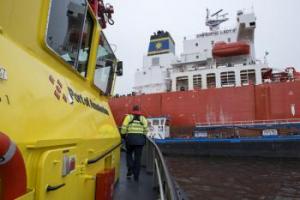Harbour Master
Harbour Masters
Worldwide there are approximately 3,000 merchant ports and the work of the Harbour Master can vary widely from country to country and from port to port even within the same country.

Port Call Optimisation is the process of realising reductions in environmental impact and improved safety and security management for shipping, terminals, and service providers.
The safety and efficiency of the maritime transport industry is dependent on the exchange of information. With the rapid advance of satellite and electronic communications, ‘port community systems’ operated by a variety of organizations that make up a seaport community will see enhanced electronic links between all parties involved in port activities. These include customs, port authorities, coastguard and others, as well as between the ship and port authority.
The Harbour Master plays a vital role in this system and increasingly may find him or herself taking on the role of an information manager at the interface between ship-and shore-based operations. With increasing frequency, ships can log onto port and terminal websites, feeding into electronic reporting systems, and may plan a port visit whilst still at sea.
Following a workshop at its 5th Congress in May 2006, IHMA embarked on a project to support Harbour Masters gathering reliable Port Entry Information and present it in a standardised format readily available to the mariner and other users. This format has been hosted on the IHMA website since July 2008. The marine industry responded to this initiative with great enthusiasm. This resulted in shipping and ports working together in an international taskforce to promote “Port Call Optimisation” by improving the quality and availability of master and event data.
This will deliver the following benefits to ports, shipping lines, service providers, and terminals:
Lower costs
Cleaner environment
Increased reliability
Better safety
Firstly, by improving the quality and availability of master data: e.g depths, admission policies. This will ensure vessel/berth compatibility and a clear understanding of when it’s safe to arrive or leave.
Secondly, by improving the quality and availability of event data: e.g planned time of arrival at the berth, estimated time of completion cargo operations. This will enable just-in-time planning of pilot on board, pre-planning of all port services and planning to the next port.
Both master data and event data use existing nautical and supply chain standards and formats suitable for shipping’s worldwide requirements.
Shipping, their agents and ports are sitting down together to discuss Port Call Optimisation, and to work on a solution that can work for every trade, for every port, from port to port and end to end. Shipping is accustomed to adapting itself to the individual port. When developing projects, shipping normally does this per trade (e.g. only for line or tramp shipping). Ports tend to develop projects for one port only, as they might be in competition with other ports.
The Standards for Nautical Port Information version 5.5 can be downloaded here.
The Port Information Guide template has been replaced by the document 'Standards for Nautical Port Information', section entitled 'General Port Information', pages 20 – 26.
The information is now more defined and structured, and duplicate entries have been removed.
For any questions on how to apply the standards please contact the IHMA Project Officer: Scherpenzeel.ehmc@harbourmaster.org, or call +31 653230439.
The Port Information Guide provides general information which applies to the entire port area. Information related to specific port sections (berths, fairways etc), can be captured via “Port Section Guides”. The format for these guides will be published in 2018.
The International Harbour Masters Association (IHMA) and the Port of Rotterdam Authority are pleased to announce the 15th International Harbour Masters Association Congress, to be held from 09–12 June 2026 at Theater Zuidplein in Rotterdam.
Naresh Sewnath, Senior Harbour Master at Transnet National Ports Authority (TNPA) in South Africa’s Port of Durban, began his maritime career back in 1988. He started out as a cadet with TNPA (then known as South African Transport Services (SATS).
Join the world’s premier professional body for harbour masters and receive up-to-date information on the industry and access to the members' area of the website.